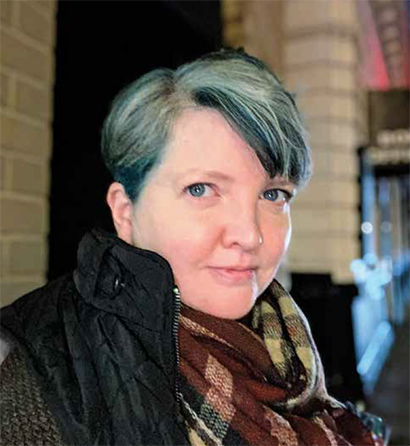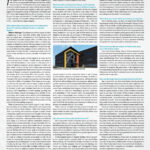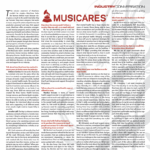
In Search of a Taxonomy of Collaborative Methods
From time to time we will come across interesting ideas that are percolating in parts of our industry and we feel our PLSN readership might want to join in the conversation. This month I came across just such an idea, in a thoughtful essay from the Chicago-based costume designer and educator Emily McConnell. Both Emily and I would be interested in your thoughts. Reach me at meddy@timelesscom.com —Michael S. Eddy, co-editor PLSN.

Several years ago, I was invited to join a team of teachers for an introductory theatre class at a local college. We came together for a training, and the first task was to get to know each other. We sat around a large set of tables—some actors, some directors, some designers. The first eight or ten people to introduce themselves were all teaching voice or movement or acting, and each one of them shared their name, their role, and then something about their methodology. “I use Alexander technique,” “I trained in the LeCoq school,” or “I work with Viewpoints.” All the other people in the room nodded as they spoke. This shared vocabulary allowed the speakers to quickly share their philosophies about their work, allowed the listeners to understand our colleagues’ work, and allowed all of us to envision how we might work together. When it came to the first designer in the circle, she said, “Well, I’m a set designer, and I mean, I just do it?” Everyone chuckled and nodded, and every other designer in the room breathed a sigh of relief because it’s what we were all thinking too.
I’ve been “just doing” costume design for over 20 years, working primarily in academic and storefront theatre in Chicago, with over 120 productions on my resume. As a theatrical designer, my work is partly about my own artistic process, but it is also largely about collaborating with other people. In my time “just doing” this work, I have had collaborations that were smooth and some that were fraught; I’ve worked with directors who told me exactly what everyone should wear and directors who had no opinions about clothes. In all that time, what I did not have is a shorthand—a common language describing how I’ve been trained as a designer and my philosophy of design collaboration. Instead, a large portion of the unspoken work of each design meeting is figuring out what methods I have in common with my collaborators and where we differ. Can theatrical designers—and the directors we collaborate with—make this process easier and free up some energy for the work of making theatre?
For many designers, one easy way to be sure that you are working with a collaborative team that shares your methods and vocabulary is to collaborate with people that you trained with—to do most of your projects with artists who came from the same graduate or undergraduate program. I certainly followed this plan for my first few professional projects after completing graduate school at Northwestern. So the first time I worked with an Off-Loop company in Chicago (let’s call them Theatre A) that didn’t involve any of my MFA cohort, I was very nervous: What would they expect of me? How would they value my particular method of sharing research and design ideas, giving and receiving feedback, and participating in shaping the show?
Eye Opening Experience
That first experience with Theatre A was eye-opening. I had stumbled into a group of collaborators that shared and valued my working methods. For me, that meant sharing copious visual research with the full design team before starting sketches; getting and giving feedback about both my own and other designers’ work with the full team; and being present for the entire tech process as the show came together. As an emerging designer, I thought I had hit the jackpot.
The second time Theatre A hired me, they had a new artistic director, and the director of the show was new to me as well. I expected that collaborative process to go just as smoothly, but the institutional expectations of design collaboration had changed with the new personnel. I fumbled through that process, discovering at each step that now the director’s expectation was to share research and sketches primarily with the director only; that this production would prioritize set design before all other areas in shaping the show; and that my feedback and opinions both in preproduction and in tech were expected to focus solely on my own design area. There are designers for whom this collaborative method will sound very comfortable. For me, it was an unpleasant culture shock, and I did not work for that company again.
Designers encounter different collaboration methods all the time across theatres, directors, and colleagues, and we are expected to easily adapt into any situation we find ourselves in. But these stories from my experience epitomize some challenges that many designers and directors run up against. We walk into any new design collaboration (whether with a single unfamiliar colleague or a whole room of them) with figurative blindfolds on, having to spend valuable time and energy feeling out everyone. When we encounter a collaboration method that doesn’t work for us as artists, it’s tempting to label that in a negative way—as old-fashioned, naive, or unrealistic. We don’t have collective language to describe these different approaches to collaboration without ascribing value, and we don’t acknowledge the preference and agency that individual designers have over their own collaboration methods. Many designers focus on the need to attune themselves to everyone else’s needs (especially the director’s), without feeling empowered to name their own.
Collaboration Talk Abounds
Looking through recent published articles and textbooks, I see clearly that the theatre community loves to write about collaboration. Theatre is a collaborative art form by nature; a single production can require dozens of different collaborative relationships to be established. A search on HowlRound for “collaboration” in May 2022 (including video, audio, and written content) had over 2,700 results, and searching for “theatre collaboration” in Routledge’s database of textbooks currently yields over 950 publications. Even within a small range of publishers, that is a treasure trove of resources.
The HowlRound content covers collaboration between directors and ensembles, between dramaturgs and playwrights, between directors and playwrights, between playwrights and ensembles. But in the first 10 pages of results, only five essays focused on design collaboration—and two of those were from a single series on women in design. Of the hundreds of Routledge textbooks featuring collaboration, the majority are geared towards actors and directors. Seventeen discuss specific design disciplines, six focus on visual elements of theatrical design, and only two specifically addressed the question of how directors and designers collaborate together. A recently published book called Production Collaboration in the Theatre: Guiding Principles—written by co-authors Rufus Bonds Jr., Maria Cominis, and Mark Ramont—takes a particularly wide view, pulling together views of collaboration from all aspects of theatremaking. Across all of these sources, collaboration is addressed for specific design disciplines or by writing about individual designers’ processes; collaboration is addressed for directors, who lead many of the collaborative relationships in theatremaking; and it is addressed for entire productions. So what is missing?
Yet There’s a Gap
I see a gap hovering right over the table where the director and designers first gather to talk about the play. The particular set of collaborative relationships established at those design meetings are unique and deserve specific attention. How do designers take their individual collaborative methods and fit them into a design team? How do directors give and receive ideas from multiple artistic voices with very different technical needs and deadlines? How does the design team as a whole work to translate the play from written words into visual art on stage? How do those collaborations change and shift in different parts of the production process, from before casting to well into the run of a show? And how are collaboration methods in design specifically affected by questions of budget, scale, theatre type, location, or audience? These are questions unique to the collaboration between director(s) and designers.
Skipping from individual artists to entire productions in our discussions about collaboration is doing this very important process a great disservice. Designers can access training and resources to feed our individual process, but very little information is available on how to navigate the challenges of combining our work with the work and processes of other artists. For directors, there are few resources on how to shift from the kind of authority they need to exercise in a rehearsal room to the various ways they could navigate working with multiple designers at once.
I’ve spoken to many designer and director colleagues in the last year about these questions and this gap, and one obstacle consistently emerges in these conversations: we can’t have a collective conversation about director-designer collaboration because every collaboration is so different. We have this perception of collaborations as unique; there are so many distinct personalities and variables involved in every production that it is overwhelming to think about finding commonalities between them. One sound designer told me that his message to design students is, “The definition of collaboration for you is going to change every day.” Many designers see our worth as a collaborator in being adaptable to any type of process, so there is a reluctance to tie ourselves to any particular way of working.
Certainly, there isn’t one single way that everyone collaborates. But there also aren’t infinite ways to collaborate in theatrical design. This perception that each collaboration is unique and therefore impossible to generalize about or categorize is getting in our way. It’s blocking our field from seeing commonalities between collaborative processes, and it’s preventing us from having clear conversations with our colleagues about how we would like our collective process to work. We have developed all these methods and schools for acting and directing methods, but designers seem to have been too busy “just doing it” to step back and look at how we work in the same way.
Bringing it All Together
My goal is to create a unique resource—a taxonomy of collaborative methods in theatrical design. Taxonomy in biology is a way of classifying the many diverse and unique life forms that science has discovered so far. It’s a project of finding similarities and differences in living things that allow them to be named, grouped, and organized. My proposal is to do this with ways of navigating the director-designer collaboration: analyze all the unique methods we have of working together and find the connections and the distinctions between them to get to a shared vocabulary.
What would having such a shared vocabulary allow us to do? It would make it easier to talk to potential collaborators about how we hope to work together; it could allow us to talk with our existing collaborative teams about ways we see our relationships shifting during a production process and reset if needed; it could provide a framework for theatres as well as artists to set ground rules for a process at the beginning of a project. One set designer pointed out to me that the establishment of group ground rules has become a standard of digital workshops and Zoom meetings over these last two years; emerging practices like this could inform our design collaborations, but only if we can get past the idea that there are too many discrete elements to describe our processes in general terms.
Certainly creating such a taxonomy will take a lot of conversations with a wide range of artists. But it provides an opportunity to create language to describe collaborative methods across disciplines. Design collaboration can become less unpredictable for directors, and designers can have more agency in their own professional practices. Clearer collaboration methodology can give established artists a way to expand their discussion of their own work; inform students and emerging artists about how to develop their own artistic voices; and provide a resource for new voices entering existing collaborative teams. A collective conversation about all the different ways we collaborate, a conversation that encompasses directors and designers of all types, can empower all of us as artists.
Emily McConnell is a costume designer, educator, scholar and all-around curious person based in Chicago. This essay was originally published on HowlRound Theatre Commons (https://howlround.com/designing-collaboration-search-taxonomy-collaborative-methods ), on May 17, 2022.


